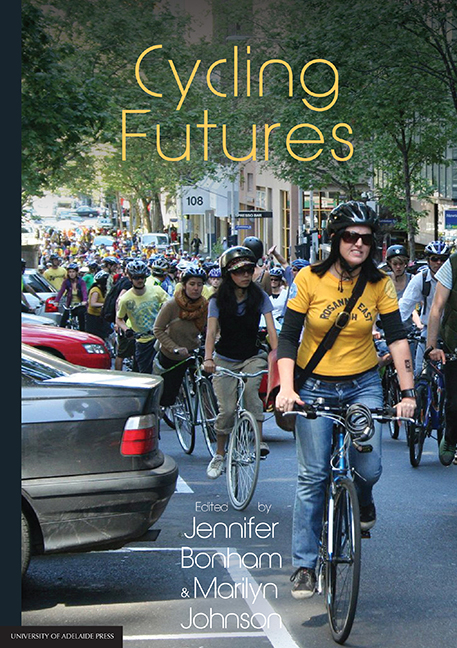Book contents
- Frontmatter
- Contents
- Preface
- Editors
- Contributors
- PART I Current challenges
- 1 Cycling: Bringing the future into the present
- 2 A glimpse at Australia's cycling history
- 3 Health benefits of cycling
- 4 An epidemiological profile of cycling injury in Australia and New Zealand
- 5 Faster than the speed of bikes
- 6 Economics of everyday cycling and cycling facilities
- 7 Cycling and sustainable transport
- 8 Cycle touring
- PART II Strategies for change
8 - Cycle touring
from PART I - Current challenges
Published online by Cambridge University Press: 25 July 2017
- Frontmatter
- Contents
- Preface
- Editors
- Contributors
- PART I Current challenges
- 1 Cycling: Bringing the future into the present
- 2 A glimpse at Australia's cycling history
- 3 Health benefits of cycling
- 4 An epidemiological profile of cycling injury in Australia and New Zealand
- 5 Faster than the speed of bikes
- 6 Economics of everyday cycling and cycling facilities
- 7 Cycling and sustainable transport
- 8 Cycle touring
- PART II Strategies for change
Summary
Introduction
The bicycle was an early facilitator of tourist mobility prior to popularisation of motorised transport in the early 1900s. Before widespread adoption of motor vehicle transportation, tourists’ mobility was largely achieved on foot, by horseback or by rail (Tobin, 1974). From an engineering perspective, bicycles evolved iteratively from inefficient and cumbersome contraptions in the 1700s to become sleek, functional means of personal transport by the late 1800s (Watson & Gray, 1978). As Fitzpatrick demonstrates (Chapter Two, this volume), the advent of functional bicycles opened up the countryside to independent tourism, freeing people from the confines of limited transportation options: ‘The individual who rode the twowheeler could travel routes beyond corridors of the railroad and also experienced the joys of motion’ (Tobin, 1974, p. 841).
However, the growing proliferation of motor vehicles in the early 1920s contributed to a decline in cycling. Associations such as the League of American Wheelmen and the Cyclists’ Touring Club in the United Kingdom sought to keep the tradition of cycle touring alive (Tobin, 1974). The nexus between cycling and tourism is long established and is therefore worthy of consideration today, especially given the recent resurgence in recreational cycling and because of challenges faced by society in the form of unsustainable, carbon-intensive modes of tourism transportation.
This chapter explores the contemporary nexus between cycling and tourism as it emphasises the significance of the bicycle beyond being simply a means of transportation. A further purpose of this chapter is to summarise the existing scholarly research examining cycling and tourism. Given this volume's focus on the Australian and New Zealand cycling context, attention is also given to discussing the manifestation of cycle tourism in Australia, with particular attention paid to conditions that may be impeding the potential of cycle tourism from being realised in Australia.
Understanding the cycle tourism market
Definitions of cycle tourism
Defining cycle tourism is a contentious issue. Whilst numerous definitions of cycle tourism have been proposed (for example, see Lumsdon, 1996; Ritchie, 1998; Simonsen & Jorgenson, 1998; South Australian Tourism Commission, 2005; Sustrans, 1999), issues such as trip purpose, motivation, trip characteristics, and the extent to which a bicycle serves as tourism transport have hampered acceptance of a universal definition.
- Type
- Chapter
- Information
- Cycling Futures , pp. 153 - 176Publisher: The University of Adelaide PressPrint publication year: 2015

